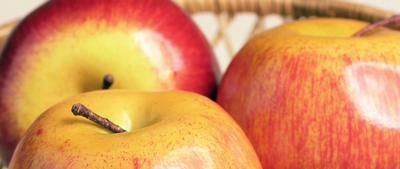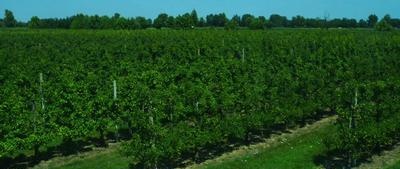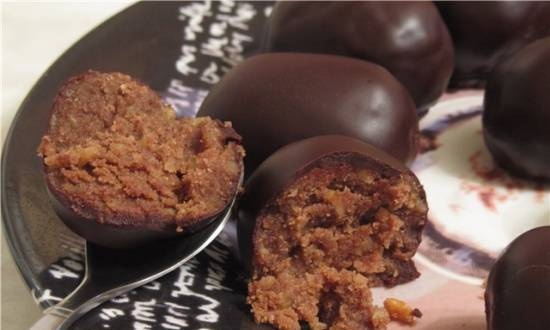|
 Antonovka is one of the favorite Russian apples. There are faceted fruits, there are glassy ones, almost like Kandil. Their sunny side seemed to be tanned to a dull yellowish color. Antonovka is one of the favorite Russian apples. There are faceted fruits, there are glassy ones, almost like Kandil. Their sunny side seemed to be tanned to a dull yellowish color.
Antonovka's aroma interrupts all other apple smells. Antonovka has been in Russia since time immemorial. Maybe she appeared just as accidentally as Simirenko, in the form of a seedling that did not go to the mother?
Perhaps, Antonovka has only one defect. Poorly stored. It is difficult to keep it longer than December. And so that a lot of apples did not disappear, they began to think about where to put them. And they came up with marmalade... From Russia, marmalade migrated to Europe, and there it spread all over the world. And now very few people remember that the beginning of it was given by the Russian Antonovka.
It is hardly possible to improve Antonovka. However Michurin tried to do it. On a young tree, he noticed an unusual branch with double shoots and double buds. I tried to cut eyes and graft. A new variety has been released - Antonovka one and a half pounds. The fruits are large, like an aport. The taste seems to be quite good. But they are stored worse than the usual Antonovka. And they freeze more.
The catchy appearance of the new varieties overshadowed one of our old magnificent northern varieties - anise. The apple is green, as if doused cherry jam... Anise is small, but the tree is strewn with fruits and the harvests follow one after another. The most important thing is the unheard-of frost resistance. Minus forty and even lower the tree withstands perfectly. No wonder Professor M. Rytov recommended it for planting "in the farthest north", where only the wild Siberian apple tree succeeds.
Disregard for anise is easy to explain. We just don't know much about him. Even the fruit business expert A. Lesevitsky was disgraced. In his catalogs, which were published in Zaporozhye, this Volga apple was praised in every way. And especially for the wonderful anise smell. In fact, anise does not smell like anise. Most of its varieties have no smell at all. If some do smell, it’s not anise.
And the variety got its name for another reason. For the fact that it lasts "until Anisya", that is, until December 30, when people are wondering about winter.
In past years, anise occupied three quarters of all gardens in the Volga region. And to this day he is held in high esteem. The trees are reaching an age unheard of for a cultivated apple tree. In the village of Bagaevka near Saratov, 150-year-old trunks are not uncommon. And in the village of Vaulin near Krasnoarmeisk there are also 200-year-olds. And bear fruit. But the average life of a cultured apple tree is fifty years old. They are trying to explain this phenomenon by the fact that anise was once taken from the seedlings that grew in the Volga region. From wild seedlings. Hence the incomparable vitality and impressive age. Whether this is so, no one knows for sure.
 And one more mystery of anise. It grows excellently in the Volga region. There it is unusually tasty. But not far away - in the Oryol region, in Ryazan and in Tula - anise is already becoming an ordinary apple. The taste is so-so. And in the Moscow region, although anise grows and bears fruit, it has neither taste nor appearance. A strong and beautiful blush seems to fade. A dull redness remains from it. What does he lack near Moscow or Orel? We don't know this yet. And one more mystery of anise. It grows excellently in the Volga region. There it is unusually tasty. But not far away - in the Oryol region, in Ryazan and in Tula - anise is already becoming an ordinary apple. The taste is so-so. And in the Moscow region, although anise grows and bears fruit, it has neither taste nor appearance. A strong and beautiful blush seems to fade. A dull redness remains from it. What does he lack near Moscow or Orel? We don't know this yet.
In general, there is still a lot of unclear things in the apple world. Take Toptygin, for example. In the Caucasus, he often trades in the thickets of the wild apple tree. Apples fall, Toptygin eats. Boars also eat. Enough for everyone. But when they still do not fall, when they are still hanging on a tree, what to do then? Very simple. You can climb a tree and pick it yourself. Mishuk climbs and vomits. But he has his own way of collecting, bearish, which misleads some witnesses of the feast. After the clubfoot has eaten, physical evidence remains in the middle of the tree - heaps of bent and intertwined branches.On this occasion, a poet from the Caucasus wrote the poem "Bear's Nests". And in them he explained the construction activity of the bear - as follows: when the bear climbs a tree and starts a meal, part of the fruit will fall to the ground from the concussion, because the procurer does not collect the food with his paws, but grabs it with his mouth. The carrion attracts wild boars. Without the bear, they themselves cannot get such wealth. The bear feels sorry for the lost.
The bear roars offended,
And the branches underneath are elastic
He weaves into a dense web.
Above her, the bear, puffing, tries,
I'm glad of my quick wit
Now does not break to the ground
And the resounding hail of pears and apples!
The Alma-Ata naturalist M. Zverev, after reading the poetry, was extremely puzzled by this turn of the matter. He met “bear nests” more than once at home, in Talas Alatau. But the boars are not there. Since there are no boars, it turns out that there is no one to save the apples from. There is no need to weave nets from branches. And Toptygin weaves ...
In fact, everything is much more prosaic than the poet described. Toptygin does not weave a web at all. He simply crushes the already eaten branches under himself, so as not to interfere with getting to the untouched ones. This is how the problem is solved: "bear - apple tree". There are others. And more complicated. We need to think over the mutual relations of apple trees with livestock, with hares, and finally, with the needs of our XX century.
Let's start with the livestock. Until the beginning of our century, the apple tree in the garden lived freely. Plenty of room. Each tree had a hundred square meters of land, or even all one hundred and fifty. Ten to fifteen paces across. Often, apple trees were placed right in the middle of the pasture, and then the four-legged, walking between the trees, plucked the lower branches. There is no harm to apple trees from such pruning, all the same, the lower branches work idle, and sometimes at a loss. For gardeners, cows and sheep have provided significant benefits. Cutting the lower branches, they created a free passage for the horse with a plow, which loosened the trunk circles. Otherwise, neither pass nor pass!
Hares are a completely different matter. The obliques show love for apple trees no less than livestock. However, they do not cut the branches, but gnaw the bark. Not only in summer. And in winter too. In summer, they gnaw even when there are solid thickets of sweet, juicy clover nearby. Ring the bark in a circular manner. And the apple tree dries up.
In the old days, they sometimes did this: they tied the trunk with straw or thorny spruce branches.
However, the troubles of apple trees are not limited to this. Gardeners began to worry about the height of the trees. The apple tree, in general, is small in stature. Six or eight meters, no more. The pine is five times higher. But even if you collect fruits from a six-meter height, you need to put up a ladder. The Australians calculated: while the gardener climbs the stairs, money, income from the garden, pours out of his pocket. On the fourth step, the pocket becomes empty. Clarified: three meters in height - the ceiling of the profit. True, a tall tree is more beautiful, elegant, but ...
In pursuit of profit, not only the height is cut. Apple rows are also compacted. A hundred-meter square is now considered an unaffordable luxury. It was cut in half, then again and again. Then the rate was reduced to ... three square meters per tree. And in the 50s, a Czech gardener proposed to shorten this meager rate to half a meter. The potato bush uses a lot! Such a compacted garden was shown at the international exhibition in Erfurt as the garden of the future. True, no one wanted to have such a garden.
However, to gardeners even such a small amount seemed an unheard of luxury. At the XVIII International Congress of Gardeners in 1970, a proposal was made to plant 16 apple trees on one meter! Sheer overpopulation. What kind of garden is it? Rather, a meadow! This is exactly what the new form of the garden was called. The idea behind an apple meadow is as follows. The seedling whips are allowed to stretch up to half a meter and sprayed with a chemical. The whips, spurred on by the poison, form fruit buds ahead of time. Two-year-old babies are already bearing fruit. Apples are not harvested from them. They mow the meadow like grass and thresh like wheat. The roots give rise to new growth.Two years later, the meadow is mown again.
Observing the truth, let us note that there are still not very many apple meadows. While they are rare. Gardeners are passionate about another idea. They undertook to plant apple trees in Paradizki. This word, until recently almost unknown to gardeners, now flashed on the pages of books and magazines. And it is no coincidence. The apple trees grafted on Paradizka can be placed on one hectare, not three or five hundred, as in an ordinary garden, but a thousand. And get a double harvest. Moreover, in a shorter time frame. Add to that: apples will be sweeter and richer in vitamin C.
 What is Paradizka? This word in translation means "heavenly" apple tree. A special kind. In Latin - "malus pumila", which means "dwarf apple tree". Its fruits, "heavenly" apples, have a mediocre taste. The tree itself grows very tightly, it is never tall. It is worth grafting a good variety to Paradizka hemp, as its growth immediately slows down. The nutrients that would have been used up for growth will now go into the harvest. It will grow. The improved apple tree will begin to bear fruit five years earlier. Collecting fruits from low trees is much easier and faster. In a day, you can collect not forty boxes, as usual, but a hundred. What is Paradizka? This word in translation means "heavenly" apple tree. A special kind. In Latin - "malus pumila", which means "dwarf apple tree". Its fruits, "heavenly" apples, have a mediocre taste. The tree itself grows very tightly, it is never tall. It is worth grafting a good variety to Paradizka hemp, as its growth immediately slows down. The nutrients that would have been used up for growth will now go into the harvest. It will grow. The improved apple tree will begin to bear fruit five years earlier. Collecting fruits from low trees is much easier and faster. In a day, you can collect not forty boxes, as usual, but a hundred.
The gardeners were about to transfer their apple trees to heavenly roots, but then someone remembered that dwarf gardens had already been planted in Russia, but for some reason they did not gain popularity. The first such garden was planted back in 1880 in Moscow, at the Petrovskaya Agricultural Academy. It existed until 1905. The second was laid near Leningrad in the thirties. He did not live very long either.
It turned out that early maturing, over-yielding dwarfs have many disadvantages. Their roots are fragile and unreliable. Each grafted tree has to be provided with an individual support. Otherwise it will tilt or fall altogether. It is expensive and troublesome. In frosty winters, the roots freeze over, because they spread near the surface. So in the north, dwarfs are not good. In the south, they are suitable, but only where there is no drought. The reason soon became clear. The dwarfs were bred in a warm, humid climate. They feel good in Kiev. It is dry in Kherson, cold in Moscow. Maybe that's why gardeners did not adopt the experience of 1880?
However, a way out of the predicament was found. Soviet breeder V. Budagovsky bred Paradizka, more resistant to frost. With its help, a new type of dwarf was created. Not in two parts, as usual, but in three. Roots and stump - from a strong to frost Antonovka seedling. The aboveground part is from a good variety. And between them - an insert, a piece of the trunk from the Paradizka Budagovsky. The complex construction survived two very harsh winters and was not damaged. Of course, there are still few gardens on Paradizki. But they are. And there will be more of them.
A. Smirnov. Tops and roots
Read now
All recipes
|
 Antonovka is one of the favorite Russian apples. There are faceted fruits, there are glassy ones, almost like Kandil. Their sunny side seemed to be tanned to a dull yellowish color.
Antonovka is one of the favorite Russian apples. There are faceted fruits, there are glassy ones, almost like Kandil. Their sunny side seemed to be tanned to a dull yellowish color. And one more mystery of anise. It grows excellently in the Volga region. There it is unusually tasty. But not far away - in the Oryol region, in Ryazan and in Tula - anise is already becoming an ordinary apple. The taste is so-so. And in the Moscow region, although anise grows and bears fruit, it has neither taste nor appearance. A strong and beautiful blush seems to fade. A dull redness remains from it. What does he lack near Moscow or Orel? We don't know this yet.
And one more mystery of anise. It grows excellently in the Volga region. There it is unusually tasty. But not far away - in the Oryol region, in Ryazan and in Tula - anise is already becoming an ordinary apple. The taste is so-so. And in the Moscow region, although anise grows and bears fruit, it has neither taste nor appearance. A strong and beautiful blush seems to fade. A dull redness remains from it. What does he lack near Moscow or Orel? We don't know this yet.





